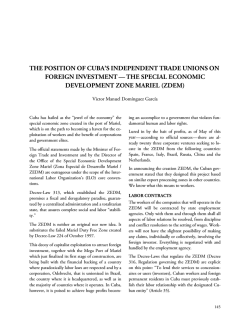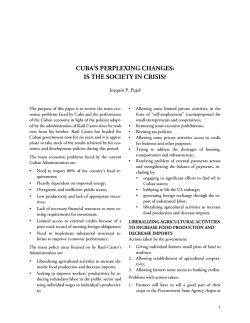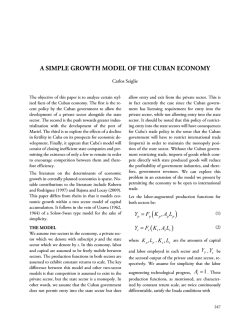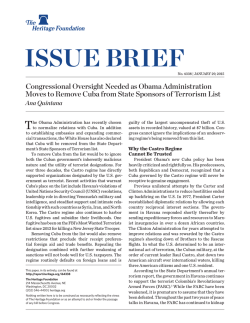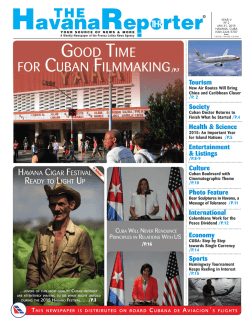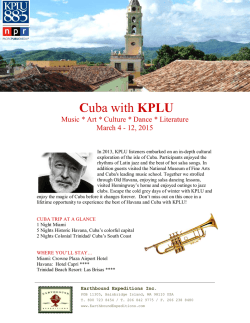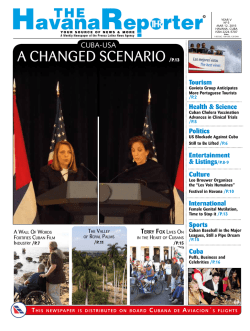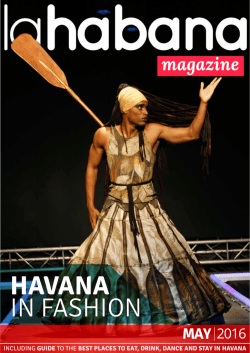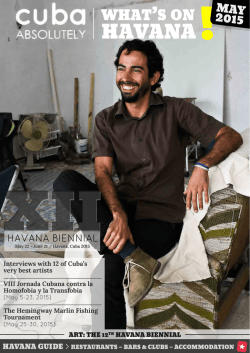
The Havana Reporter
HavanaReporter THE © YOUR SOURCE OF NEWS & MORE A Weekly Newspaper of the Prensa Latina News Agency The Habano festival and How to Make a Cigar /P.14 YEAR V Nº 4 FEB 23, 2015 HAVANA, CUBA ISSN 2224-5707 Price: 1.00 CUC, 1.00 USD, 1.20 CAN Tourism Cuba Diversifies Tourism Products /P.3 Health & Science Cuba Boosts Anti-Cancer Program /P.5 Politics CUBA-USA: On a Long Road To Normalization /P.6 Entertainment & Listings /P.8-9 Culture Books, Books, Books, Everywhere /P.10 Cuban Jazz Made by Women: Twice as Interesting /P.10 International Vladimir Malakhov Creates Further Accolades for Cuban Ballet /P.7 Chinesse Delegation to Visit Cuba for Air Route /P.12 Vietnamese Company Plans to Build Factories in Cuba /P.13 Sports Siboney, A Thoroughbred Cuban Bear Will Cuban Baseball Win Another Crown? /P.15 /P.11 This n e w s pa p e r i s d i s t r i b u t e d o n b o a r d Cubana de Aviacion´s flights 2 CUBA TOURISM 3 Cuba Diversifies Tourism Products AS SPANISH BUSINESS RECOMMITS TO THE ISLAND, MINISTER DISMISSES “AVALANCHE” OF US ARRIVALS AND FORECASTS AN INCREASE IN EUROPEAN VISITORS MADRID.- Following a season during which Cuba welcomed a record number of more than three million visitors, the tourism sector aspires to ensure a significant increase in the number of European holidaymakers due to renewed interest from continental travel agencies. In an interview with the Havana Reporter, Cuba’s Minister for Tourism, Manuel Marrero, highlighted hotel company, airline and tour operator projections of increased activity in the country. As proof that these are more than hollow words, in September the Melia company will open its largest hotel in the world in Cayo Coco and from June, Iberia will again operate five Madrid-Havana flights per week. Iberia’s return, an extension of Evelope operations and the maintenance of both Cubana Airlines and Air Europa schedules, will bring to 16 the number of weekly flights on this inter-capital route which, in Marrero’s opinion, will represent an increase of somewhere between 25 and 30 thousand travellers annually. Undoubtedly the renewed interest by Spanish and European companies arises because of the start of U.S.Cuba talks to restore diplomatic relations, a move that could lead to the normalization of bilateral ties. According to Gabriel Escarrer, vice-president of Melia, the reestablishment of relations could open the door for U.S. tourism to Cuba, although he accepted that the process required time. Minister Marrero is of the same view, assuring that there will not be an avalanche of American tourists and that European companies prefer to position themselves in time to improve their options in preparation for the day that U.S. competition becomes a reality. PHOTOS: FotosPL. By MiguelLOZANO Without banking on future developments or abandoning traditional sun and beach holidays, Cuban authorities are looking towards diversified developments to broaden the scope of what is on offer. In addition to further new hotels planned for Havana, Varadero and the archipelago’s keys, there are significant world class cultural, health, nature and other tourism sector developments. With regard to Cuban tourism options, Minister Marrero explained during his visit to the recently held Madrid International Tourism Fair that work was underway to diversify beyond the beach and sun product on offer. He said that without abandoning the beach holiday model, holidaymakers are now being offered heritage and cultural experiences that are most attractive to European visitors in particular. Marrero referred to the construction of a water park in Varadero, to be concluded in 2016, by the Cuban company Palmares, in a joint venture with Spanish firms and the contemporaneous development of various golf courses and complexes. He added that another significant element was a heritage based sector, which had necessitated accelerated investment in hotels in various cities in order to satisfy unmet demand. Marrero commented that the specialized cultural tourism agency, Paradiso, had been bolstered as the Ecotur nature tourism agency was being. The minister recalled that in the area of health tourism, the Ministry for Public Health’s Cuban Medical Services company, in conjunction with tourist institutions had, based on scientific advances, capacity and qualified specialized staff, expanded their list of services on offer. With more than 7,500 guest houses and over 2,500 restaurants (locally known as paladars), the non-state sector offers complimentary alternatives, he added. In his view, flexibilization of the categories for U.S. citizens travelling to Cuba, decreed by president Barack Obama, had resulted in a collateral interest by European companies in expanding their dealings with Cuba. The minister emphasized that they anticipate new opportunities going forward in Cuba, which stimulate interest in investment in tourism. Marrero told businessmen in Madrid that those already established are seeking to expand their interests and others recognize that the time has come to close deals, adding that all would be attended to. Cayo Largo, The Perfect Place to Unwind in Cuba HAVANA._ In a world where recreational travel is a priority for many people, Cuba has the perfect place for leisure tourism: Cayo Largo del Sur, a small resort island off the south coast of the Cuban mainland. The renowned travel website TripAdvisor has named Paraíso Beach, in Cayo Largo, as one of the world’s 25 most visited beaches, according to a poll of thousands of tourists who have visited the spot. Once an isolated Cuban location, Cayo Largo features particularly colorful surroundings, with beautiful beaches and secluded sites where environmental protection efforts are encouraged; making it an ideal spot for tourism. The place combines history, magic and great tourism options, including activities such as underwater photography and hiking. Largely consisting of plains, the area, which is only a few meters above sea level, has a land surface of 38 square kilometers-its longest stretch being 27 kilometers. The Marlin Marinas and Navigation Business Group plans to increase the number of nautical leisure activities and new projects, mainly those related to diving on keys such as Cayo Largo. Marlin business group’s sales manager in Cayo Largo del Sur, Ángel Tornes, told The Havana Reporter that their plans include Marina Colony, of the hotel with the same name, in the special Cuban municipality of Isla de la Juventud (Isle of Youth), in the Canarreos Archipelago. PHOTOS: FotosPL. By RobertoCAMPOS He added that tourism-related activity started in Cayo Largo in 1982 after the first hotel was built (Hotel Isla del Sur), with an incipient marina service available. The key hosted the fifth edition of the International Underwater Photography Festival, Fotosub 2014, held in May. Tornes said that in Cayo Largo del Sur, Marlin currently has a fleet of 22 craft, and another six in Colony Marina, as well as an international port that can accommodate 30 vessels drafting up to 3m. The inclusion of Colony Marina facilitates the organization of interesting programs such as The Route of Galleons and the Route of Indians, which connect Cayo Largo, Colony, and the sea town of La Coloma, in the westernmost province of Pinar del Río, allowing for a greater variety of diving offers in Cuba. Similarly, Cayo Largo del Sur has a sea turtle protection program, while Colony Marina manages another program involving tourists in the protection of manatees, ensuring that the leisure industry goes hand in hand with environmental protection. Colony Marina offers a comprehensive project that every year involves 300 students from the United States and the United Kingdom, who go there to dive and participate in scientific and eco-friendly activities. For such nautical activities, the key has seven Cuban Gran Caribe hotels, some run by foreign firms. The hotels are Playa Blanca, Isla del Sur, Coral, Soledad, Linda Mar, Sol Pelícano and Sol Cayo Largo, with about one thousand rooms total. The largest hotel is Sol Pelícano with 307 rooms, followed by Hotel Playa Blanca with 306. The latter hosted Fotosub 2014. Canada and Italy send the largest number of tourists to Cayo Largo del Sur, followed by the United Kingdom, France and Germany, with a rise in the number of tourists from Russia and visitors from other countries, including Switzerland, the Netherlands, the Czech Republic, and Poland. Cayo Largo’s international airport receives direct flights from Milan and Rome (Italy), Toronto and Montreal (Canada), with visitors coming from Buenos Aires, Argentina, during the high tourist season (November-April). 4 SOCIETY Iron Bridge Spanning Time PHOTOS: Emilio Herrera. By JorgeHERNANDEZ HAVANA._ Known locally as the Iron Bridge, this structure, the only one of its kind in the Cuban capital, has been given a new lease on life by a renovation that has facilitated its reopening as a link over the Almendares river between the two important residential zones of Miramar and Vedado. Constructed in the U.S. early in the 20th century, its main task in Havana was to provide a tram service for unfettered eastbound urban sprawl at a time when the Linea and Fifth Avenue tunnels had not even been dreamed of. As time passed, trams lost out to buses and the Iron Bridge was redesigned; the rails were removed from the structure to facilitate use by other vehicles and pedestrians. The bridge’s centrally supported horizontal turn table allowed ships to pass beneath and enter shipyards on either bank of the Almendares. Authorities responsible for the restoration of the time-ravaged bridge decided for total replacement with a similar technologically modern new structure of the same design. The project, which was concluded in late 2014, incorporated respect for patrimonial values and the use of existing original civil and mechanical elements in order to facilitate a flow of river and road traffic on or over the Almendares. With a high quality marine steel structure, an effective rust resistant coat of paint, advanced turn and lash technology and a cabin housed centralized operational control center, the Iron Bridge continues to serve Havana, thanks to an intensive restoration with a final price tag of almost $1.5 million. Cuba Creating First Audio Dictionary for the Blind SANTIAGO DE CUBA._ Specialists from the Center for Applied Linguistics (CAL) are preparing the first acoustic dictionary for the visually impaired in Cuba, which will be a useful tool for broadening their horizons. The institution’s director, Leonel Ruiz, hopes that the volume will be completed next July after a complex development process that involves the recording of more than12,000 words and entries by local radio broadcasters. He commented that the work was well underway and that to the very best of his knowledge, there are very few, if any, dictionaries of this type in Latin America or the Caribbean. Ruiz referred to the attention paid to word spelling, the quality control checks that each step is subjected to and the added value that the book will have given its expected use by persons of advanced age. He highlighted the involvement of young people in the project which will compliment the Basic School Dictionary and many other Spanish learning and language development texts, including those for foreign language students, as a CAL product leader. This worthy endeavor is being led by a founder of the center, Dr. Vitelio Ruiz, also a member of the Cuban Academy of Sciences who has been blind himself for decades. PHOTO: FotosPL. By MartaCABRALES HEALTH & SCIENCE Cuba Boosts Anti-Cancer Program PHOTOS: FotosPL. By AlfredoBOADA HAVANA._ Cuba is in the process of introducing the required technology to integrate five new cancer diagnostic and treatment innovations into the national public health system that will have a significant social impact on the population. Cancer is the primary cause of death in Cuba and in order to address this issue, to reduce mortality, to improve the life quality of patients and to convert the disease to a chronic condition, the Ministry of Public Health is implementing an Integrated Cancer Control Program. The program guarantees universal access to all levels of health care, from the local family doctor’s consulting room to the poly-clinic and hospital, with primary actions focusing on prevention, early diagnosis, timely treatment, rehabilitation and care for sufferers backed-up by a primary health care system that facilitates the early detection of health problems by doctors. On a different front, Cuban researchers have made significant progress in their search for new cancer treatments and instruments to improve disease diagnosis and prevention. The island’s scientists have, over recent years, developed natural medicine therapeutic vaccines against cancer. Mayka Guerrero, Technology Introduction director at the Center for Medical and Surgical Research (CIMEQ for its Spanish initials) told The Havana Reporter during a scientific event to mark the 20th anniversary of the Nuclear Energy and Advanced Technologies Agency that Cuba is making an important effort regarding resources to drive technological developments for accurate diagnosis and more effective treatment of cancer. Among such new technologies Guerrero mentioned a radioactive isotope cyclotron or particle accelerator device used for positron emission (PET-CT technology) in tomography chambers to facilitate the visualization of metabolic tumor images. She commented that three such PETCT devices are to be installed in medical institutions in Havana. According to the expert, the equipment will allow for a cancer diagnosis well in advance of the appearance of any anatomical manifestation. Guerrero added that “we are going to be one step further in cancer diagnosis and treatment evaluation.“ One such device has been installed in the Oncology Hospital and two others are to be located at the Hermanos Ameijeiras Hospital and another at CIMEQ. She said that in regard to treatment, a High Intensity Focused Ultrasound (HIFU) machine, the first in the Latin American region, had been installed at the CIMEQ. Guerrero recalled that this innovation, which permits the ablation of tumor related damage, is of particular use for uterine fibroid. As part of the program two intraoperative radiotherapy machines have been installed and they should come into service within the next few months. She emphasized that these would be used for the treatment of breast cancer. These facilitate surgery and tumor extirpation and the subsequent application of a single dose of radiation therapy on the tumor bed, thus reducing the duration of external radiotherapy treatment and permitting the control of radiation induced side effects. Two lineal electron accelerators, which are technologically superior to those operating in the country and will permit real-time treatment management, are also coming online. There are presently 203 tumor diseases classified as cancer which cause more deaths than HIV/AIDS, tuberculosis and malaria combined. In Cuba, Medical Oncology is developed within the National Medication Program with an increasing number – from 28 in 1999 to 67 in 2014 -- of available pharmaceuticals which, in spite of their high international prices, are distributed freely to every cancer patient. 5 6 POLITICS CUBA-USA On a Long Road To Normalization By RobertoGARCIA HAVANA._ The announcements of last December 17 by Cuba and The United States about the reestablishment of diplomatic ties, broken by Washington in 1961, created great expectations in both countries. Just over one month later, on January 21 and 22, representatives of both governments met in Havana where they agreed upon a course of action for the reestablishment of diplomatic relations. In the meeting, the Cuban side once again made clear that the economic, commercial and financial blockade that Washington has imposed on the Caribbean island for more than 50 years is still the main obstacle to normalization. President Barack Obama is to a large extent responsible for this because he could use his executive powers to “bury the most fundamental instruments of the blockade.” This was the view expressed by Josefina Vidal, Director General for the United States at the Cuban Foreign Ministry, who led the host delegation at the aforementioned negotiations. Obama took a step in the right direction by facilitating measures to ease some restrictions that took effect last January 16, but these, among many other things, simply amount to a readjustment of U.S. imposed prohibitions on travel to Cuba, while the blockade remains in force. The changes allow for certain commercial transactions, mainly in the telecommunications sector, and the possibility for U.S. financial institutions to start operations in Cuba. Nevertheless, there are many aspects of U.S. Cuba policy that only the Congress can lift, one of which is the prohibition on U.S citizens traveling as tourists to Cuba. While president Obama does not have the legal authority to allow Cuban enterprises to trade with their American counterparts in third countries, he could permit transactions with corporations located in the U.S. Moreover, Obama does not have the power to permit the granting of credit facilities for the purchase of goods or services by U.S. financial institutions to their Cuban counterparts while payments must be made in cash in advance. These are some of the elements that will make the road to normalization difficult and long, which is why both sides consider that time and effort are required to resolve these and other complicated issues. This first impulse has aroused strong interest within the American business community, which is endeavoring to take advantage of new opportunities. In this regard, the American Airlines, United, Jetblue, Southwest and Delta corporations announced their intention to initiate itineraries to Cuba, but their representatives have cautioned that such expressions are subject to their government’s approval. Meanwhile, Executives at both the American Express and MasterCard companies have expressed interest in exploring business opportunities in Cuba, although, as yet, no dates or other details have been forthcoming. In keeping with the enthusiasm inspired by the new bilateral political climate, Republican senator Jeff Flake has proposed legislation to end the travel ban on U.S. visitors to Cuba. According to experts, this and other actions attest to the more favorable environment for the convincing of those on Capitol Hill that the policy of unilateral sanctions is totally obsolete and even harmful to the interests of the United States. A poll recently conducted by Associated Press and public opinion research company GFK revealed that 60 percent of U.S. citizens believe that the White House should lift the blockade against Cuba and that just 35 percent are in favor of maintaining it. The survey also shows that around 45 percent of those polled support the reestablishment of diplomatic relations between both nations and only 15 percent do not. SCHEDULE OF UPCOMING EVENTS . . . . . . 18th International Livestock and Trade Fair, Rancho Boyeros exhibition site, Havana. March 17-21. 13th Health for All Fair, Pabexpo exhibition center, Havana. April 20-24. 36th International Tourism Fair, Jardines del Rey archipelago, central province of Ciego de Ávila. May 5-7 “Arte en la Rampa” Handicraft Fair, Pabellón Cuba exibition site, Havana. June-August. 32nd International Fair of Havana, Expocuba exhibition center. November 2-8. 19th International Craft Fair, Pabexpo exhibition center, Havana, December. CULTURE 7 SPOTLIGHT ON Vladimir Malakhov Creates Further Accolades for Cuban Ballet By MarthaSÁNCHEZ HAVANA._ One of the world’s leading ballet stars, Ukrainian Vladimir Malakhov, has created more prizes and scholarships for summer courses at two U.S. Ballet companies for the winners of the International North Atlantic Dance Contest in Cuba. The event, sponsored by the local contemporary dance company Codanza, will once more be held in the eastern province of Holguín from September 20 to 30. Dancers between the ages of 18 and 35 will have an opportunity to win the Vladimir Malakhov Grand Prix with a pas de deux, a classical solo or a neoclassical, or a contemporary performance that does not exceed ten minutes. It has been announced that the second edition of the event offers new prizes such as the Vladimir Malakhov Grand Prix for Best Company, the People’s Choice Award, and the Paul Seaquist Award. The latter award will grant scholarships for summer courses at the prestigious Alvin Ailey Ballet Company of New York, and Joffrey Ballet Company of Chicago; both in the United States. Cuba’s Codanza Company will continue to award the Choreography Grand Prix, named after the institution. Entries for this prize must present a ballet piece never performed before or premiered less than one year earlier of no more than 10 minutes long. The deadline for registration is July 30. The contest’s first edition brought together 75 partipants and, according to organizers, showcased the high quality of Cuba’s ballet in the country’s central and eastern regions where this type of performance dance is not as commonplace as in the capital. The event, originally a dance contest, has become a wonderful festival, Malakhov said at the closing of the first edition, when the winners were the Cubans Lisbeth Saad, for her role as Edith Piaf in Non, choreographed by Osnel Delgado, and Carlos Carbonell for his performance in the ballet “Pasajera la lluvia” (Transient Rain) choreographed by Nelson Reyes. For its part, Codanza granted the Choreography Grand Prix to Joel González from Danza Fragmentada Company of Guantánamo for his “Estáticos” (Static) piece. The director of the International North Atlantic Dance Contest studied at the prestigious Russian Bolshoi school and starred with the largest U.S. Ballet company, the American Ballet Theater, where he shared the stage several times with the great Cuban dancer José Manuel Carreño. With amazing flexibility and control of his 46 year old body, the artist directed the Berlin State Opera Ballet for nearly ten years and currently has that same responsibility at the Ballet Company of Tokyo, Japan. Malakhov performed for the first time in Cuba during the International Ballet Festival of Havana in 2010, when he decided that he would certainly return to the Caribbean island to offer his art. He kept his word and came back within three years, but instead of returning to Havana he traveled to the province of Holguín, the city that first welcomed him. He had arrived there without expectations and without knowing anyone –he never imagined receiving so many expressions of affection and finding such outstanding ballet. Thus the link between the artist and the Cuban province was forged and has continued to earn recognition not only within the country but abroad as well. Drums Return to Beat New Rhythms HAVANA._ The International Guillermo Barreto Memorial Festival, popularly known as the Drum Festival, is returning soon to keep a promise made to percussion and casino dancing. Giraldo Piloto, president of the organizing committee, said that the festival will run from March 3 to 8 with a program featuring the traditional percussion contest, in addition to concerts and performances. “Our collaboration with the dancers is inevitable,” said Piloto, who also directs the klimax band. Choreographer Santiago Alonso is organizing a show that will combine dance and percussion, he added. As in previous years, the international contest will have five categories: kettledrums, bongos, drums, conga and batá drums, with no academic requirements for contestants. A casino dancing competition has also been announced. This competition was first held last year to rescue casino dancing, a style that identifies Cubans within the world of salsa music. “Over the past few years casino dancing has been losing popularity among young Cubans, who barely know the basic steps, and we want to revert that PHOTOS: FotosPL. By CharlieMORALES situation, because this important dance is disappearing into oblivion,” said Piloto. Casino is the traditional Cuban way of dancing salsa and owes its name to a style that evolved in the 1950s at the Casino Deportivo Club ballroom in Havana. The dance is based on three points making a circular motion by couples who face each other using intricate arm and body movements and features a “rueda de casino” in which partners form a circle and dance steps called out by one person. Performers of this genre, such as Adalberto Álvarez, have already undertaken actions to rescue the dance, and now Piloto sustains that the Guillermo Barreto Memorial Festival is becoming a space for fostering this way of salsa dancing. The upcoming festival promises to be one of the most attractive cultural events of the year in Cuba, which will also host the Salsa World Festival for the first time next August. 8 ENTERTAINMENT THEATER *Note: theater companies are in parentheses Centro Cultural Bertolt Brecht GETTING (THR is not responsible for any changes made by sponsoring organizations) By MaylínZALDIVAR [email protected] RECOMMENDS • “Punto Ciego” (Blind Spot) by Rosario Cárdenas Dance Company at Sala Teatro Hubert de Blanck. Adolfo Llauradó Calle 13 esquina a I. Vedado. Tel: 832-9359. Sala Tito Junco. Fri. Feb. 27, Sat. 28 (8:30 pm): Rent (musical) directed by Andy Señor Jr. Sala Café Teatro. Fri. 27, Sat. 28 (8:30 pm): “Huevo” (Egg) by (Mefisto Teatro). Calle 11 e/ D y E. Vedado. Tel: 832-5373. Feb. 27, Sat. 28 (8:30 pm): “Divorciada, Evangélica y Vegetariana” (Divorced, Evangelical and Vegetarian) by (Trotamundo). Casa Victor Hugo MUSIC MUSIC Museo Nacional de Bellas Artes O’ Reilly e/ Habana y Aguiar. Habana Vieja.Tel: 866- 7591. Sat. Feb. 28 (5 pm): Concerts by Vocal Leo vocal ensemble and Móviles Trio. Asociación Yoruba Prado e/ Montes y Dragones. Habana Vieja. Tel: 863-5953. Fri. Feb. 27 (8:30 pm): Obbiní Batá folk band. Sun. Mar. 1 (4 pm): Los Ibellis folk band. Sala Hubert de Blanck Patio- Bar Egrem Teatro Trainón Línea e/ Paseo y A. Vedado. Tel: 830-9648. Fri. Feb. 27, Sat. 28 (8:30 pm): “Decamerón” (The Decameron Tales) by (Teatro El Público). Oratorio San Felipe Neri Calle Aguiar esq. Obrapía. Habana Vieja. Tel: 862-3243. Thu. Feb. 26 (7 pm): Clarinetist Arístides Porto and pianist Lianne Vega in concert. San Miguel e/ Campanario y Lealtad. Centro Habana. Tel: 864-2006. Thu. Feb. 26 (4 pm): Tanda de Guaracheros septet performs. Sat. 28 (5 pm): Singer Roberto Orta Luis. Fri. 27 (4pm): Rumberos de Cuba band’s club. Sat. 28 (4 pm): Explosión Sonera Salsera band’s club. Calzada entre A y B. Vedado. Tel: 830-1011. Fri. Feb. 27, Sat. 28 (8:30 pm): “Fuenteovejuna” by (Compañía Hubert de Blanck). El Sótano Teatro Raquel Revuelta ART GALLERIES MUSEUMS AND GALLERIES & MUSEUMS Trocadero e/ Monserrate y Zulueta, Habana Vieja. Tel: 861-0241.Hemiciclo de Arte Universal. Sat. Feb. 28 (3 pm): Guitar performances. Casa Victor Hugo Museo de Lombillo Empedrado Esq. Mercaderes. Habana Vieja.Tel: 860- 4311. Through Feb. Painting exhibit “El camino que te busca” (The Road that Calls You) by landscape painter Carlos Alberto Casanova. Factoría Habana Calle O´ Reilly e/ Habana y Aguiar. Habana Vieja. Tel: 8649518. Through Feb. Painting exhibit “Occidente tropical” (Tropical West) by Esterio Segura. Museo Numismático Calle Obispo e/ Aguiar y Habana. Habana Vieja. Tel: 861-5811. Through Feb. Exhibit “Pasajes históricos en la Numismática” (Historical Moments in Numismatics), featuring bills and coins. Casa Africa Obra Pía e/ San Ignacio y Mercaderes. Habana Vieja. Tel: 861-5798. Through Feb. Exhibit marking the 39th anniversary of the Sahrawi Arab Republic. Museo Napoleónico (Napoleonic Museum) San Miguel # 1159. Vedado. Plaza de la Revolución. Tel: 879-1412. Through Feb. Exhibit “La vajilla de la Dolce Dimora” (Dolce Dimora’s Dinner Set) Casa del Benemérito de las Américas Benito Juárez Basílica Menor San Francisco de Asís Obrapía e/ Mercaderes y Oficios. La Habana Vieja. Tel: 861- 8166. Through Feb: Exhibit “Nuevas tentaciones de Narciso” (Narcissus’ New Temptations). Casa Oswaldo Guayasamín Calle K e/ 25 y 27. Vedado. Tel: 832-0630. Fri. Feb. 27, Sat. 28 (8:30 pm): “Especiales” (Special) by (Estudio Teatral la Chinche). Sala Argos Teatro Línea esquina a B. Vedado. Tel: 833-0225. Sala Raquel Revuelta. Fri. Feb.27, Sat. 28 (8:30 pm): “El Zapato sucio” (Dirty Shoe) by (Teatro D´ Dos). Ayestarán y 20 de mayo. Plaza de la Revolución. Tel: 878-5551. Fri. Feb.27, Sat. 28 (8:30 pm): “Locos de amor” (Madly in Love) by (Argos Teatro). Oficios e/ Amargura y Churruca, Habana Vieja. Tel: 862-9683. Sat.Feb. 28 (6 pm): D´Accord duo performs (pianist Marita Rodríguez and clarinetist Vicente Monterrey). O’ Reilly e/ Habana y Aguiar. Habana Vieja.Tel: 866- 7591. Through Feb. 26 (10 am): Exhibition Víctor Hugo, Great Painter (made up of books showing some of the French writer’s drawings). Through Feb. 28: Photo exhibit “Meliponas o Abejas de la tierra de Cuba” (Meliponas or Cuba’s Ground Bees) by Samuel Perichon, president of the French Association in Cuba; Jorge Demedio, professor at Havana’s Agrarian University; and Mariline Dubois, French student and photographer. Obra Pía e/ Oficios y Mercaderes. La Habana Vieja. Tel: 861- 3843. Fri. Feb. 27 (5 pm): Opening of the exhibit “HistoGrama” (Histo-Gram) by Aissa M. Santiso Camiade. ENTERTAINMENT AROUND Casa Asia Café Miramar NIGHTCLUBS & CABARETS Diablo Tun Tun NIGHTCLUBS & CABARETS DANCE 9 DANCE Sala Teatro Hubert de Blanck Centro Cultural Bertolt Brecht Calzada entre A y B. Vedado. Tel: 830-1011. Fri. Feb. 27 and Sat. 28 (8:30 pm): Show “Punto Ciego” (Blind Spot) by Rosario Cárdenas Dance Company (several dance styles). Calle 13 esquina a I. Vedado. . Tel: 832-9359. Sala Estudio. Feb. 26 (10 pm): Pedro Luis Ferrer and his band. Submarino Amarillo Teatro Mella Calle 5ta y 94. Miramar. Tel: 203-7676. Fri. Feb. 27 (5pm): Gens band (rock). Sat. 28 (5 pm): Singer Ihosvany Bernal and guests (trova music). Sat. 28 (10 pm): El Chispa y los Cómplices band performs. Línea entre A y B. Vedado. Tel: 833-8696.Fri. Feb. 27, Sat. 28 (8:30 pm): Performances by students from the National School of Ballet. Centro Habaneciendo Mercaderes e/ Obrapía y Obispo. La Habana Vieja.Tel: 863- 9740. Exhibit of 2015 Japanese calendars on Japan’s culture, art, society and development. Calle 17 esq. 12, Vedado, Habana. Tel: 830-6808. Live rock nightly in this Beatles-themed nightclub (10 pm-3 am). Calle 5ta y 94. Miramar. Tel: 203-7676. Salón te Quedarás. Fri. Feb. 27 (10 pm): Klimax band (popular music). Sat. 28 (5 pm): Gens band (rock). ONLINE SALES OF PHOTOGRAPHS BY THE PRENSA LATINA NEWS AGENCY Galiano e/ Neptuno y Concordia, Centro Habana. Tel: 862-4165. Fri. Feb.27 (4 pm): “A Coffee with Rosalía¨. Sat. 28 (5 pm): “A Havana afternoon with Cary Bridón¨and guests 8th edition of Women in Jazz Festival Date: March 2-7 Venue: La Zorra y el Cuervo Jazz Club FOR PHOTOS OF CURRENT EVENTS, OR HISTORIC PHOTOS FROM OUR ARCHIVES, GO TO OUR WEBSITE: o /f / : s p tt h m o c . l p tos OUR SITE IS 100 PERCENT SECURE, AND WE GUARANTEE IMMEDIACY AND QUALITY!!! FOR MORE INFORMATION, CONTACT US!!! TELEPHONE: (537) 830-1344; (537) 830-2276 EXT. 120; AND (537) 834-6528. EMAIL: [email protected] or [email protected]. HavanaReporter A Weekly Newspaper of the Prensa Latina News Agency THE President: Luis Enrique González. Information Vice President: Víctor M. Carriba. Editorial Vice President: Maitté Marrero Canda. Chief Editor: Luis Melián. Translation: Prensa Latina English Department. YOUR SOURCE OF NEWS & MORE . . . . . SOCIETY HEALTH & SCIENCE POLITICS CULTURE ENTERTAINMENT PHOTO FEATURE ECONOMY SPORTS AND MORE Graphic Designers: Mario Sombert. Laura Reyes. Chief Graphic Editor: Alejandro Gómez. Advertising: Pedro Ríoseco Circulation: Commercial Department. Printing: Imprenta Federico Engels. . Publisher: Agencia Informativa Latinoamericana, Prensa Latina, S.A. Calle E, esq. 19 No. 454, Vedado, La Habana-4, Cuba. Telephone: (537) 838-3496 / 832-3578 Fax: (537) 833-3068 E-mail: [email protected] 10 CULTURE Books, Books, Books...Everywhere By MarthaSÁNCHEZ HAVANA._ If you are visiting Cuban places other than Havana you may happen to come across alternative venues for Cuba’s largest cultural event: The International Book Fair. Opened in the Cuban capital on February 12, the event has more than five million books for sale, with representatives from 35 countries in attendance. According to the president of the fair’s organizing committee, Zuleica Romay, Cuba’s publishing houses are offering nearly 200 books for children and youth, as well as more than 800,000 maps, toy books, and didactic puzzles. As guest of honor country to this 24th edition of the fair, India has brought representations from 13 publishers with books on the most diverse themes, including architecture, science, poetry, yoga, and health. India’s Secretary of State for Culture, Ravindra Singh, thanked the Cuban Book Institute and Indian institutions for translating 27 Indian classical works into Spanish, of which 100,000 books were printed to be sold at the fair at reasonable prices for Cubans, he said. The ongoing book fair is dedicated to Cuban writers Olga Portuondo and Leonardo Acosta (winner of the 2014 National Music Award). According to the event’s organizers, this could be a suitable framework for a cultural rapprochement between Cuba and the United States after the announcement made last December 17, when they agreed to begin a process for re-establishing diplomatic relations. Romay believes the book fair could be a right space for the U.S. book industry and at the same time be profitable for Cuba. Meanwhile, the fair’s president referred to the book Who Killed Che?, written by U.S. writers Michael Ratner and Michael Steven Smith, as one of the most attractive titles presented at the fair. They researched the book using declassified CIA documents, revealing that entity’s role in the persecution and assassination of the Argentinean-Cuban guerrilla Ernesto Che Guevara. The fair is now spreading to the rest of the Cuban provinces with numerous proposals for all types of readers, ranging from children, students, scientists, and professionals from different fields and readers interested in art, cuisine, and sports; also including dictionaries and other publications. By DamiánESTRADA HAVANA._ The result of women’s charm and good jazz getting together is a formula created in Havana: Women in Jazz, an event that returns to the capital with new airs after four years of absence. From March 2 to 7, Women in Jazz will bring together the most representative elements of jazz made by women. The upcoming 8th edition intends to remain loyal to its initial goals and delight the audience at the mythical La Zorra y el Cuervo Jazz Club, the traditional headquarters of this music event. As usual, Women in Jazz will be hosted by pianist and composer Lilia Expósito, popularly known as Bellita who, along with the organizing committee, will have the difficult task of inviting the most outstanding jazz singers and instrumentalists of the Cuban capital. “This is just the beginning; Cuban women will be ever more talented in jazz. Women performers are becoming aware of the fact that one does not earn popularity because of who one performs with but because of how one performs,” Bellita commented referring to the event’s first editions. According to her, these times are just perfect to show that there are good women instrumentalists in Cuba, and they will grow even more as long as the competition gets tougher. Recognized in Cuba for her creativity and leadership capacity, Bellita will spare no efforts to, along with her Jazztumbatá band, design an attractive place for all those jazz lovers who attend the event at the central jazz club. Though La Zorra y el Cuervo Club regularly welcomes jazz performers, the event’s organizers agree that this is a unique opportunity to further highlight and make the work of Cuban women in jazz known. The event’s main organizer is Waldo N. Cárdenas Asen, the artistic producer of this and many other music events in Havana, always with jazz and its best exponents as his letter of introduction. Directed by Cárdenas, talented musicians such as Pablo Menéndez and his band Mezcla, Yissi García, Roberto Fonseca & Temperamento, and Bellita & Jazztumbatá have made memorable performances including the tribute paid to maestro Bebo Valdés and those at the Jazz Plaza Festival on December 13, 2013. These precedents envisage five days of jazz fully performed by women, with serious performances that will allow corroborating Bellita’s predictions in the prelude to the music event. Its date has certain symbolism because International Women’s Day is celebrated the day after its closing. No doubt, the best present for Cuban women would be seeing these great women artists performing a musical genre they have gradually taken on as their own. PHOTO FEATURE Siboney, A Thoroughbred Cuban Bear By ReinaMAGDARIAGA HAVANA._ A pack of bears have taken over San Francisco de Asis Plaza in Havana, each one painted by an artist from the country they represent; just like Siboney, a purebred Cuban forest creature with whom domestic and foreign visitors have their souvenir photo taken. Cuban artist Nancy Torres told The Havana Reporter that her acrylic and collage creation is a form of tribute to the indigenous Cuban Indian community who welcomed Christopher Columbus in 1492. She said that her national representation in the exhibit, “which I made lovingly by hand and which incorporates typical Cuban symbols such as tobacco and our national flag”, is due to remain in place until the month of March. Torres forms part of the German United Buddy Bears project which creates life-sized bears that travel the world to promote international unity. On this occasion they carry a message of peace, tolerance and understanding between peoples, cultures and religions. She added that there can be no peace on earth without tolerance, which is why we oversee the mounting of the exhibit which opened in Berlin, back in 2002. The artist believes that “tolerance requires acceptance of others just as they are, regardless of their ideology”. As part of the exhibit, an auction of a miniature version of the Cuban bear will be held in the square where the bears are on show. Torres explained that the purpose of the auction is to raise funds for the benefit of Cuban children. The artist expressed a deeper satisfaction for the appreciation of her creation by the Cuban public in the context of peace and tolerance between peoples. WELL DESERVED RECOGNITION Eva Herlitz,creator of the United Buddy Bears Exhibit, said that she was very happy that the Cuban artist was on board. Since their first outing in Germany, the bears have visited Vienna, Cairo, Jerusalem, Buenos Aires, Montevideo, Paris, Hong Kong, Istanbul, Tokyo, Sydney, Warsaw, Rio de Janeiro and other cities. Herlitz confirmed that during this world tour, more than 30 million people had been charmed by the Cuban bear. She emphasized that “it is true to say that it is one of the most admired”, a reality also reflected by viewers in Cuba. Eusebio Leal, Havana City´s Historian, considers the event beautifully symbolic, not only regarding its desired universal accord but specifically regarding the friendship between both nations. He said that the creatures, invigorated with the colors through which each artist views their world, express here a vision of openness and tolerance. Leal commented that although tolerance is very important, he believed in something superior; a wanting not to be just tolerated but to be respected. And so, he said, this is a beautiful invitation to come from all over the world to a Havana where bears proclaim better times. 11 12 INTERNATIONAL Chinese Delegation to Visit Cuba for Air Route By IlsaRODRIGUEZ BEIJING._ Zhang Xin, a senior Air China executive, said that a company delegation will travel to Cuba for talks about the establishment of the first ever direct flight between Beijing and Havana. The head of Governmental, International and Bilateral Cooperation Affairs at Air China, told the Prensa Latina news agency that company representatives will arrive in Havana midMarch, seeking Cuban approval for their proposed operations. The purpose of the visit will be to reach an agreement and to become familiar with refuelling, maintenance, catering and other services and facilities at José Martí airport. He added that once Cuban approval had been secured, pertinent applications would be submitted to Chinese authorities. On that basis, he said that the flights could start next September 28. The executive participated in a Tourism promotional event at the Cuban diplomatic mission in Beijing, which was also attended by Chinese officials from travel agencies and tour operators. Zhang explained that the journey between two such distant points by long haul Airbus or Boeing aircraft would take 16 hours and involve a fuel stop at Montreal, Canada. The Cuban Ambassador, Alberto Blanco, expressed his satisfaction with the airlines plans to open the first ever direct BeijingHavana connection, which will coincide with the 55th anniversary of diplomatic relations between both nations. Blanco recalled out that in 2003 Cuba was the first Latin American country to have been declared a tourist destination for China and highlighted that security, natural beauty, high environmental protection indicators and a range of exotic sites, make Cuba a most attractive destination. In addition to such characteristics, the Ambassador mentioned growing interest in the economic transformations underway in Cuba, the shared enduring friendship and respect for the Chinese presence on the island. Ecuadorian Government Reduces Poverty By Almost 15% QUITO._ The government of Ecuadorian president Rafael Correa has reduced the income based poverty index by almost 15 percentage points since 2007. According to the National Planning Department (SENPLADES for its Spanish initials), the national income based poverty rate at the end of 2014 stood at 22.5 percent. SENPLADES confirmed that eight years ago the rate reached 36.74 percent and that by December 2013 it had fallen to 25.55 percent. Official figures released by the Ecuadorian Statistics and Census Institute indicate that in December 2007 the rate of extreme poverty was 16.45 percent, that in the same month in 2013 it was 8.61 percent , and in 2014 it was further down to 7.65 percent. The National Planning Department recalled that poverty reduction required the prioritization of areas such as health related issues, employment, education and income generation, in which the government was making the most important public investment in the nation´s history. Nationally, the government has designed a program to close the inequality gap by responding to the basic needs of the population. Correa recently said that thousands of families experienced an improved quality of life and had been removed from poverty as a result of governmental policies during this period. Ecuador is among the Latin American countries that have most reduced poverty. The President said that, “all going well, we will hand the nation back in 2017 with an absolute poverty rate of 3 percent.” He commented that the Amazonian region, despite representing 5 percent of the population, was most vulnerable, with poverty rates reaching 22 percent, a result of the exclusion the region had endured during successive administrations. The Head of State said that the eradication of this scourge in Amazonia was realistic because the population could be reached by way of inclusive developmental socioeconomic projects. PHOTO: FotosPl. By YudithDIAZ INTERNATIONAL 13 Vietnamese Company Plans to Build Factories in Cuba Mariel Special Development Zone in the western Cuban province of Artemisa. HAVANA._ The Vietnamese Thai Binh Investment Trading Corporation is promoting a project to construct detergent and diaper factories within the Mariel Special Development Zone (ZEDM for its Spanish initials) in the western Cuban province of Artemisa. Early in 2015, Tran Thien Minh, general manager of the Cuban branch of Thai Binh, told the Prensa Latina news agency about the company’s plans for this year. Vietnam is among 30 countries that have submitted proposals to invest in the enclave, which is located 48km from the Cuban capital and whose first projects should get underway this year. Tran said that “we have been in the Cuban market since 1998 and after having received a license from the Cuban Chamber of Commerce we officially established our branch in Havana.” He also recalled that Thai Binh was one of the first Vietnamese companies to trade with the Caribbean countries, adding that their Havana office is responsible for commercial activities with Cuban enterprises such as TRD Caribe, Cimex, Tecnotex, Divep and Ferreterias Universales. In earlier days we exported clothes, shoes, perfume lines and food and we PHOTO: Ligia María Fernández. By DuongBUI later expanded into other areas such as building materials, hardware, furniture, electro-domestic and home products, he commented. The Vietnamese businessman said that this year Thai Binh also had a range of school materials on offer. The manager explained that among the difficulties that hamper better commercial relations with Cuba are delays in the transportation of containers due to the long distance between both nations and market competition from China in particular which can offer merchandise at better prices. He stressed that the “company´s strategy is to adjust prices and improve product quality to satisfy the needs of increasingly demanding customers.” Tran referred to efforts to elevate the prestige of “made in Vietnam” products as one of the more pressing objectives. Thai Binh participated in the 31st International Havana Trade Fair (FIHAV 2013 for its Spanish initials) where they got the go ahead for their Miss Saigon perfume design which has allowed them to increase their range of products and to improve their acceptance in the marketplace. 14 ECONOMY CUBA The Habano Festival and How to Make a Cigar Text and Photos by RobertoCAMPOS Natasha Vasilievna. HAVANA._ An added value asset of the February 2015 edition of the Habano Festival will be the teaching and learning about how cigars are made and what their most important characteristics are. The Habano Festival is a very interesting event which will bring more than 1,000 people of around 80 nations together and will provide an instructive as well as a commercial platform for participants. The now traditional annual program illustrates significant elements, such as how to roll a cigar, to participants. An expert cigar maker always presents a master class which, in addition to explaining to those in attendance how a cigar is made, affords them the opportunity to make themselves under expert supervision. On their entry to the seminar, the organizers give participants a kit containing an apron, a board and a roller´s knife, three typical cigar making tools which also serve as lasting souvenirs of their trip to Cuba and their participation in the Cigar Festival. The classes culminate in accompanied visits to factories and plantation areas – usually in the western province of Pinar del Rio which is renowned for quality tobacco –two days very much enjoyed by participants. The latter ask many questions as they observe workers rolling cigars in the factory and other details of interest to any cigar smoker, such as quality control checks and the traditional reading of news or other material to workers. This is the point at which many discover the supremacy of necessarily careful and experienced women in the delicate and very complex craft of cigar rolling. Most of the cigar makers who gently caress tobacco leaves in order to produce two new Partagás brand cigars for example, possess the most delicate of characteristics. This was reiterated by Adela Reyes, a Quality Control expert at Partagás, an industry founded in 1845 by Spaniard Don Jaime Partagás. With more than 30 years´ experience in the tobacco sector, Reyes said that the P Series represented a Pyramid (cigar type) made of superior quality material and that the Reserve is made from tobacco leaves that have been aged for no less than three years. She assured that this carefully handled leaf of exceptional quality is only given to the finest makers within the industry, who may be replaced by somebody better able to maintain standards in an increasingly efficient industry if any drop in work quality is noted. During a visit by the author of this article to a factory, he met with a Ukrainian lady who has been 20 years in Cuba, during 10 of which she has been making cigars, rolling P Series. In spite of difficulties that one might imagine a European could have practicing a typically tropical trade, she is considered to be an expert in the making of this exclusive product. Natasha Vasilievna commented that she became hooked on the craft following a nine month course and her perception that it seemed like very rewarding work. Vasilievna rolls 120 or 130 cigars during a day´s work for which 110 is the target. She recalls that she increased her grades as a maker over the years. Beatriz Chacón is a beautiful mulatta who dedicates her energies to making Partagás Reserves, an exclusive brand often referred to by technicians as an aged robust. Curiously, neither Chacón nor her Ukranian colleague smokes. However, both are expert Cuban cigar makers. Natasha said that, given her love for the work, she had not found it difficult to learn the craft. The Habano Festival proudly brings participants close to the world’s best traditional Premium (hand made) cigars, due to the triple ingredients of soil, climate and producer expertise. SPORTS 15 Will Cuban Baseball Win Another Crown? By RafaelARZUAGA HAVANA._ Long before the efforts to bring baseball into the Olympic Games´ program became known, the annals of sports history had recorded its inclusion in the first Pan American Games, hosted by Buenos Aires in 1951. The passion for baseball in this region had opened the way for the sport of balls, strikes and home runs to be included in the program of the Buenos Aires games and the successive tournaments showered them with stimulating stories of Cuban teams in the vortex or –to say the least- as a point of reference. The story of Cuban baseball may be told in as many ways as one may like or from any perspective, but there is always something categorical about it: In the Americas, Cuban baseball features irrefutable dimensions as it has traditionally topped all major competitions. As the forthcoming Toronto Pan American Games draw near, it is worth recalling that Cuba boasts 12 continental crowns, including 10 consecutive titles spanning almost four decades. However, like all empires, the one built by Cuban baseball has also had its dark days and Canada has been present for almost each of them as a rival and, for most, as the venue. Before the 1967 Winnipeg Pan Am Games, the Cuban team had grabbed two of the continental titles granted until then; the last conquered in Sao Paulo in 1963. In 1967 The Cuban squad landed in Winnipeg with the explicit wish of renewing its top class. Nevertheless, the US team won a 5-4 final game against right-handed pitcher Manuel Alarcón to close a play off that crushed the Cubans´ dream and gave the winners their first and only title in Pan Am games. Cuba did not lose again to the US in a final of any official tournament until the 1981 Inter-continental Cup. From then on, the Cubans were the masters of baseball in the Americas and one could say they ruled with a strong hand. In finals, the Cubans have beaten the US, the Dominican Republic, Puerto Rico and Nicaragua and their victories sparked off spontaneous celebrations in all corners of this Caribbean island. It was so until the games returned to Winnipeg, which hosted their 13th edition and at which professional players were first seen. Thus, in terms of quality and rivalry, the tournament was well above any other held until then. In Winnipeg, Cuba lost to both the US and Canada –unbeaten until the semifinalsand came close to losing the gold medal game, until the island´s team proved its class once again and took the title. The crown was retained at the 2003 and 2007 games, giving further credit to Cuba´s top class baseball. Now, months from the 2015 Toronto Games, Canada again represents a challenging venue for Cuban baseball. Yes, because after having won the 2014 Veracruz Central American Games and the Caribbean Series, a return to the top position in continental baseball would be like a triple impact blow. Should it happen, the Cubans would, firstly, recover the crown won by the Canadians in Guadalajara four years ago. Secondly, they would be the champions in a tournament featuring 11 of the world´s 20 best teams. Lastly, Cuba would win the titles in three important competitions – regardless of their level – to vindicate the quality of the baseball of a team that did not fair well in earlier international tournaments. Cuba´s Heritage Cities with our E Hotels Trinidad Santiago de Cuba Matanzas Remedios Velasco Trinidad Mesón del Regidor La Ronda Camagüey La Avellaneda Santa María El Marqués Camino de Hierro Gibara Santiago de Cuba Ordoño Barcelona Mascotte San Basilio www.cubanacan.cu www.hotelescubanacan.com Camagüey
© Copyright 2026
